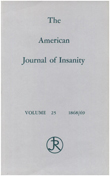Clinical and neuropsychological characteristics of patients with late- onset schizophrenia
Abstract
OBJECTIVE: The goal was to compare clinical and neuropsychological characteristics of patients with late-onset schizophrenia, a poorly studied and controversial entity, with those of patients with early- onset schizophrenia and normal subjects. METHOD: The authors evaluated 25 patients who met DSM-III-R criteria as well as their own research criteria for late-onset schizophrenia (i.e., schizophrenia with onset after age 45) and compared them with 39 patients with early-onset schizophrenia and 35 normal subjects in this nonepidemiologic study. RESULTS: Patients with late-onset schizophrenia were similar to patients with early-onset schizophrenia and different from normal subjects on most clinical and neuropsychological variables assessed, such as psychopathology, family history, childhood social adjustment, and overall pattern of neuropsychological impairment. Compared with the early-onset group, the group with late-onset schizophrenia had a higher percentage of patients who were ever married, a better work history, and a greater frequency of paranoid subtype. CONCLUSIONS: These results support the diagnostic validity of schizophrenia with onset after the age of 45 years.
Access content
To read the fulltext, please use one of the options below to sign in or purchase access.- Personal login
- Institutional Login
- Sign in via OpenAthens
- Register for access
-
Please login/register if you wish to pair your device and check access availability.
Not a subscriber?
PsychiatryOnline subscription options offer access to the DSM-5 library, books, journals, CME, and patient resources. This all-in-one virtual library provides psychiatrists and mental health professionals with key resources for diagnosis, treatment, research, and professional development.
Need more help? PsychiatryOnline Customer Service may be reached by emailing [email protected] or by calling 800-368-5777 (in the U.S.) or 703-907-7322 (outside the U.S.).



